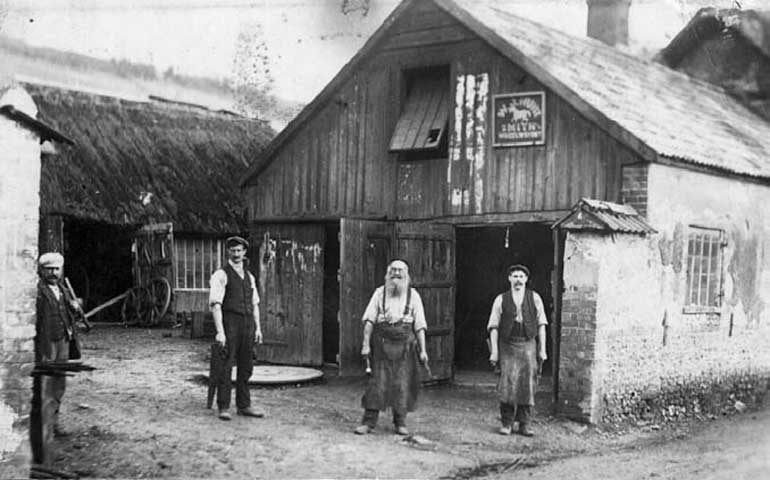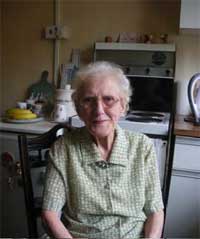Interview with Joan Hunt 6th September 2010
My grandfather, William Joseph HUNT (5-12-1850 m.28-04-1874 Emily Ailles 20-03-1844) was probably the first person to run the forge. His parents had come to Piddletrenthide to live in their retirement. William and Emily had 5 children: George Ailles (b.1875 & d. aged 13yrs), Kate Beatrice (b.1878) Emily (b.1881) Malina Hannah (b.1883) & Charles Matthews my father (b.7-11-1885). Charles was sent to school aged 3 years old with his three sisters as his brother was ill.

© Joan Hunt
The house behind the Forge was quite large with four bedrooms, two living rooms, a kitchen & scullery, but of course, no bathroom ! It was originally thatched but after it caught fire the roof was replaced with galvanised sheeting. Many years later, when a new building was put up for welding, the old house was pulled down.
After Granny died, Grandfather continued to live at the Forge with Charles, until he married in 1913. Bill Chalke lived there too whilst he worked for William. Someone came in to clean and Mrs Sturmey from Doles Ash came in to collect the washing. When William caught pneumonia the doctor said he couldn't carry on living there alone & he moved in with my family at Kirby Cottages for 7 years until his death at the age of 86.
My father Charles started working at the Forge at the age of 14 although of course he would have been helping out there at weekends and holidays before then. He preferred working with wood so he would have been the wheelwright whilst my grandfather did the blacksmithing. After William retired Charles was obliged to turn his hand to shoeing. The iron for the shoes was supplied by Thomas Reynolds in Bristol and arrived by train at Dorchester where Harry Hawker's carrier's cart collected it and transported it back on the roof to the forge. Timber was collected in the same way on Thursday afternoons (Early Closing Day in Dorchester) from Hutchings Sawmill in Hazelbury Bryan. The plank shed was behind the house and was used to store the timber whilst it was seasoned. This building was at right-angles to the house and made of wood and tiles
I remember in the Forge hand bellows being used until we had electricity. There was a second forge although I don't recall seeing it in use. When a long piece of iron was being worked it was passed through the archway into the forge through a little wooden hatch opened on the door by the road. The village was very quiet in those days with little traffic! The entrance for customers was where it is now; wheel-bonding took place in the outside area. Wilf, Harry Hawker's son, used to do odd jobs for us and helped with wheelbonding, hammering, pouring water on to cool the metal and even gardening. My granddad used to call him Snowball because of his blond hair!
The Forge was always a very busy place: shoeing the horses as all the farms had several horses and no tractors in the 1920's! Also wheel bonding, the children used to love watching that. My Dad used to build waggons and putt carts or dung putts. I used to enjoy watching him in the carpenter's shop, rather than when he was shoeing the horses, although they stood very quietly. My earliest memory is my grandfather doing the shoeing until he retired in 1920's then my Dad took over and later my late brother, George.

'Aunty Joan' © Rachel Hunt
The forge had a great fascination to the children coming from school, looking over the half door. Probably the fire was some attraction, kept alight by large bellows which were pumped by hand until electricity arrived in the 1930's. What a relief this must have been! Wheel bonding was a big event. The Bonding Stone was in the yard over which the wooden wheel was put. The Iron Bond was heated and shut in the fire, then carried out to the wheel whilst still hot and put on the wheel. A lot of hammering - sledge hammers and then cold water was poured on to shrink tight. This took several men!
The garden behind the house was planted right to the top. Sometimes my friends and I used to go to school or come home this way, running along the edge of Closes and down Tullons Lane. Grandad had a large fruit cage half way up the garden. I expect that was the attraction !
Bridget + Dave Bowen
